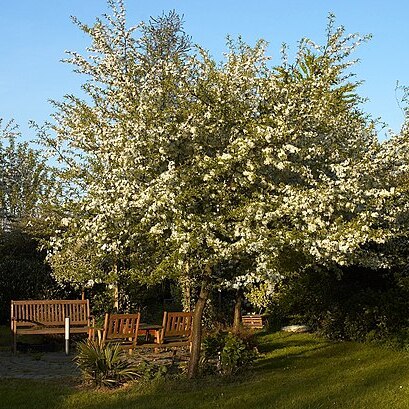Shrubs 2–6 m tall. Branchlets spreading, dark purple or purplish brown, terete, puberulous when young, glabrescent; buds purplish brown, ovoid, glabrous or only terminal scales puberulous at margin. Stipules narrowly lanceolate, 4–6 mm, herbaceous, slightly puberulous, margin entire, apex acuminate; petiole 1–2.5 cm, puberulous; leaf blade ovate, elliptic, or narrowly elliptic, 3–7.5 × 2–4 cm, both surfaces puberulous when young, abaxially puberulous along midvein and lateral veins when old, adaxially subglabrous, base rounded or broad cuneate, margin serrate, often 3-lobed, rarely 5-lobed on new branches, apex acute. Corymb at apices of branchlets, 4–6 cm in diam.; 4–8-flowered; bracts caducous, linear-lanceolate, membranous, adaxially pubescent, margin entire, apex acuminate. Pedicel 2–2.5 cm, pubescent or subglabrous. Flowers 2–3 cm in diam. Hypanthium campanulate, subglabrous or pubescent. Sepals ca. as long as or slightly longer than hypanthium, abaxially glabrous, adaxially tomentose, margin entire, apex caudate-acuminate. Petals pinkish, elliptic-obovate, 1.5–1.8 cm, base shortly clawed, apex rounded. Stamens 20, unequal, ca. 1/2 as long as petals. Ovary 3–5-loculed, with 2 ovules per locule; styles 3–5, slightly longer than stamens, villous basally. Pome red or brownish yellow, subglobose, 6–8 mm in diam.; sepals caducous; fruiting pedicel 2–3 cm. Fl. Apr–May, fr. Aug–Sep. 2n = 34*, 51*.
More
A deciduous tree. It grows 10 m tall. It is a broad weeping shape. The bark is dark grey and cracks into small plates. The leaves are narrowly oval and 6 cm long by 3 cm wide. They taper to a point and have teeth. They are a matt deep green above and paler underneath. They are downy on both sides when young. They can have 3-5 lobes. The flowers are 2 cm across. They are pink in bud and open white. They have 5 petals and a scent. They occur in small clusters. The fruit is rounded and red or yellow. They are 1 cm across. They are on slender stalks.

